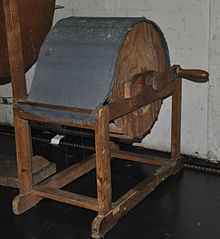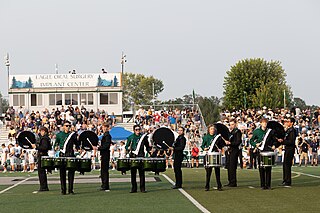

The wind machine (also called an aeoliphone or aelophon) is a friction idiophone used to produce the sound of wind for orchestral compositions and musical theater productions. [1]


The wind machine (also called an aeoliphone or aelophon) is a friction idiophone used to produce the sound of wind for orchestral compositions and musical theater productions. [1]
The wind machine is constructed of a large cylinder made up of several wooden slats which measures approximately 75–80 cm (30–31 in) in diameter. The cylinder body of the instrument rests upon a stand and is typically covered with silk, canvas, or other material which is in a fixed position. A crank handle, used by the player to rotate the cylinder and create the sound, is attached to the cylinder. [2]
Another method of construction implements an electric fan, which is fitted with lengths of cane, rather than blades. However, this method is less popular because it does not provide the player with the ability to control the speed of rotation. [3]
The wind machine is played by rotating the crank handle, which is attached to the cylinder, to create friction between the wooden slats and the material covering that touches the cylinder but does not rotate as the crank handle is turned. This friction between the wood and the material covering creates the sound of rushing wind. The volume and pitch of the sound is controlled by the rate at which the crank is turned. The faster the handle is turned, the higher the resulting pitch and the louder the sound. The slower the handle is turned, the lower the pitch and the softer the volume. The sound of the wind machine can also be controlled by the tightness of the fabric covering the cylinder. [1] [4]

The vibraphone is a percussion instrument in the metallophone family. It consists of tuned metal bars and is typically played by using mallets to strike the bars. A person who plays the vibraphone is called a vibraphonist,vibraharpist, or vibist.

The glockenspiel or bells is a percussion instrument consisting of pitched aluminum or steel bars arranged in a keyboard layout. This makes the glockenspiel a type of metallophone, similar to the vibraphone.

The Archimedes' screw, also known as the Archimedean screw, hydrodynamic screw, water screw or Egyptian screw, is one of the earliest hydraulic machines. Using Archimedes screws as water pumps dates back many centuries. As a machine used for transferring water from a low-lying body of water into irrigation ditches, water is pumped by turning a screw-shaped surface inside a pipe. In the modern world, Archimedes screw pumps are widely used in wastewater treatment plants and for dewatering low-lying regions. Run in reverse, Archimedes screws turbine acts as a new form of small hydroelectric powerplant that can be applied even in low head sites. Such generators operate in a wide range of flows and heads, including low heads and moderate flow rates that is not ideal for traditional turbines and not occupied by high performance technologies. The Archimedes screw is a reversible hydraulic machine, and there are several examples of Archimedes screw installations where the screw can operate at different times as either pump or generator, depending on needs for power and watercourse flow.

Timpani or kettledrums are musical instruments in the percussion family. A type of drum categorised as a hemispherical drum, they consist of a membrane called a head stretched over a large bowl traditionally made of copper. Thus timpani are an example of kettle drums, also known as vessel drums and semispherical drums, whose body is similar to a section of a sphere whose cut conforms the head. Most modern timpani are pedal timpani and can be tuned quickly and accurately to specific pitches by skilled players through the use of a movable foot-pedal. They are played by striking the head with a specialized drum stick called a timpani stick or timpani mallet. Timpani evolved from military drums to become a staple of the classical orchestra by the last third of the 18th century. Today, they are used in many types of ensembles, including concert bands, marching bands, orchestras, and even in some rock bands.
Hornbostel–Sachs or Sachs–Hornbostel is a system of musical instrument classification devised by Erich Moritz von Hornbostel and Curt Sachs, and first published in the Zeitschrift für Ethnologie in 1914. An English translation was published in the Galpin Society Journal in 1961. It is the most widely used system for classifying musical instruments by ethnomusicologists and organologists. The system was updated in 2011 as part of the work of the Musical Instrument Museums Online (MIMO) Project.

Tubular bells (also known as chimes) are musical instruments in the percussion family. Their sound resembles that of church bells, carillon, or a bell tower; the original tubular bells were made to duplicate the sound of church bells within an ensemble. Each bell is a metal tube, 30–38 mm (1+1⁄4–1+1⁄2 in) in diameter, tuned by altering its length. Its standard range is C4–F5, though many professional instruments reach G5. Tubular bells are often replaced by studio chimes, which are a smaller and usually less expensive instrument. Studio chimes are similar in appearance to tubular bells, but each bell has a smaller diameter than the corresponding bell on tubular bells.

A bearing is a machine element that constrains relative motion to only the desired motion and reduces friction between moving parts. The design of the bearing may, for example, provide for free linear movement of the moving part or for free rotation around a fixed axis; or, it may prevent a motion by controlling the vectors of normal forces that bear on the moving parts. Most bearings facilitate the desired motion by minimizing friction. Bearings are classified broadly according to the type of operation, the motions allowed, or the directions of the loads (forces) applied to the parts.

A crank is an arm attached at a right angle to a rotating shaft by which circular motion is imparted to or received from the shaft. When combined with a connecting rod, it can be used to convert circular motion into reciprocating motion, or vice versa. The arm may be a bent portion of the shaft, or a separate arm or disk attached to it. Attached to the end of the crank by a pivot is a rod, usually called a connecting rod (conrod).

Temple blocks are a type of percussion instrument consisting of a set of woodblocks. It is descended from the muyu, an instrument originating from eastern Asia, where it is commonly used in religious ceremonies.

The flexatone or fleximetal is a modern percussion instrument consisting of a small flexible metal sheet suspended in a wire frame ending in a handle. Used in classic cartoons for its glissando effect, its sound is comparable to the musical saw.

A ratchet or rattle, more specifically, cog rattle is a musical instrument of the percussion family and a warning/signaling device. It operates on the principle of the ratchet device, using a gearwheel and a stiff board mounted on a handle, which rotates freely. Variants include the gragger used in Judaism, the rapach, and the raganella.

The cabasa, similar to the shekere, is a percussion instrument that is constructed with loops of steel ball chain wrapped around a wooden cylinder. The cylinder is fixed to a long, wooden or plastic handle.

A connecting rod, also called a 'con rod', is the part of a piston engine which connects the piston to the crankshaft. Together with the crank, the connecting rod converts the reciprocating motion of the piston into the rotation of the crankshaft. The connecting rod is required to transmit the compressive and tensile forces from the piston. In its most common form, in an internal combustion engine, it allows pivoting on the piston end and rotation on the shaft end.

Marching percussion instruments are percussion instruments specially designed to be played while moving. This is achieved by attaching the drum(s) to a special harness worn by the drummer, although not all marching bands use such harnesses and instead use traditional baldrics to sling their drums.

The lion's roar is a membranophone instrument that has a drum head and a cord or horsehair passing through it. It gets its name from the sound it produces, which closely resembles a lion's roar. The home-made lion's roar is a drum that sits on the floor. The cord then makes friction with the drum head as it is moved back and forth.

A friction drum is a musical instrument found in various forms in Africa, Asia, Europe and South America. In Europe it emerged in the 16th century and was associated with specific religious and ceremonial occasions.
A clapper is a basic form of percussion instrument. It consists of two long solid pieces that are struck together producing sound. They exist in many forms in many different cultures around the world. Clappers can take a number of forms and be made of a wide variety of material. Wood is most common, but metal and ivory have also been used. The plastic thundersticks that have recently come to be popular at sporting events can be considered a form of inflated plastic clapper.

The modern timpani evolved in the 18th and 19th centuries from the simple 12th-century membranophone of the Naker to a complex instrument, consisting of a suspended kettle with a foot-operated clutch, capable of rapid tuning. The technological evolution of the instrument led to increased interest in its capabilities and sound among such composers as Joseph Haydn, Ludwig van Beethoven, Robert Schumann, and Hector Berlioz.

The terpodion or uranion is a keyboard instrument which produces sound using the same friction principle as the glass harmonica.
Traditional French musical instruments, known as instruments traditionnels in French, are musical instruments used in the traditional folk music of France. They comprise a range of string, wind, and percussion instruments.